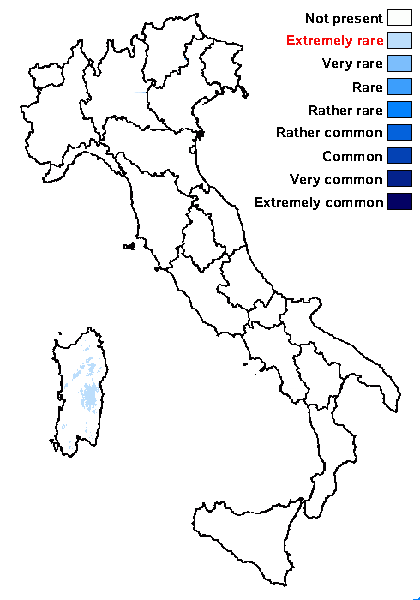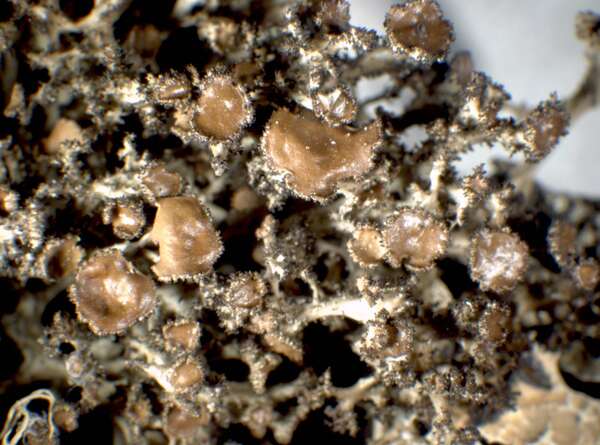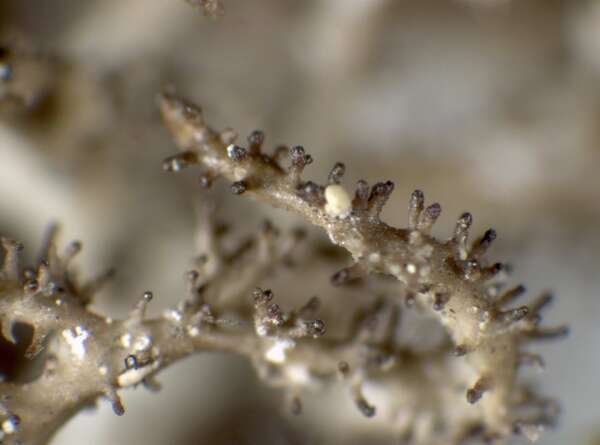Cetraria crespoae (Barreno & Vázquez) Kärnefelt
Bryologist, 96: 39, 1993. Basionym: Coelocaulon crespoae Barreno & Vázquez - Lazaroa, 3: 236, 1982.
Synonyms:
Distribution: C - Sar (Nöske 2000).
Description: Thallus fruticose, erect, stiff, tufted 1-3 cm high, pale to dark olive-brown, rather glossy, attached by small prostrate branches with hapters, branching mainly dichotomously, more or less terete, 0.5-1.5 mm thick, the apical branches covered in dense, simple to branched, 0.2-0.5(-1) mm long, dark brown spinulose projections. Pseudocyphellae abundant, oval, more or less crateriform, to 0.8 mm long. Cortex 70-100 μm thick, 2-layered, brown and paraplectenchymatous in upper part, colourless and prosoplectenchymatous in lower part; medulla white, rather lax. Apothecia lecanorine, terminal or subterminal, 0.3-2-(6) mm across, with a brown, glossy, flat to slightly convex disc, and a thin, rough thalline margin covered in spinulose projections and pseudocyphellae. Epithecium brown; hymenium colourless, 35-50 μm high, I+ blue; paraphyses coherent, the apical cells slightly swollen; hypothecium colourless, underlain by a dense algal layer. Asci 8-spored, cylindrical-clavate, Lecanora-type. Ascospores, 1-celled, hyaline, globose or subglobose, 4-6 x 3.5-4 μm. Pycnidia immersed in the spinules. Conidia oval to cylindrical. 4-5 x 1-1.5 μm. Photobiont chlorococcoid. Spot tests: thallus K-, C-, KC-, P-, UV-. Chemistry: without lichen substances.Note: described from the Iberian Peninsula, growing on shrubs, especially Juniperus in open, windy situations, known from a few stations in Sardinia. According to Lutsak & al. (2020), molecular data do not confirm the distinction from C. aculeata.
Growth form: Fruticose
Substrata: bark
Photobiont: green algae other than Trentepohlia
Reproductive strategy: mainly sexual
Subcontinental: restricted to areas with a dry-subcontinental climate (e.g. dry Alpine valleys, parts of Mediterranean Italy)
Commonnes-rarity: (info)
Alpine belt: absent
Subalpine belt: absent
Oromediterranean belt: extremely rare
Montane belt: extremely rare
Submediterranean belt: absent
Padanian area: absent
Humid submediterranean belt: absent
Humid mediterranean belt: absent
Dry mediterranean belt: absent

Predictive model
Growth form: Fruticose
Substrata: bark
Photobiont: green algae other than Trentepohlia
Reproductive strategy: mainly sexual
Subcontinental: restricted to areas with a dry-subcontinental climate (e.g. dry Alpine valleys, parts of Mediterranean Italy)
Commonnes-rarity: (info)
Alpine belt: absent
Subalpine belt: absent
Oromediterranean belt: extremely rare
Montane belt: extremely rare
Submediterranean belt: absent
Padanian area: absent
Humid submediterranean belt: absent
Humid mediterranean belt: absent
Dry mediterranean belt: absent

Predictive model
 Index Fungorum
Index Fungorum
 GBIF
GBIF





